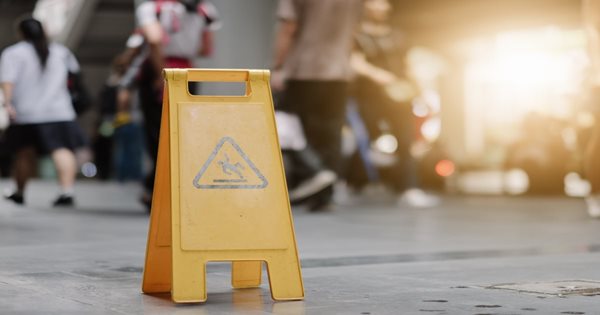Restaurant workers face many potential risks in their day-to-day duties that could lead to a variety of injuries and lost time in the workplace. Every restaurant has unique characteristics that also lead to unique risks.
Matt Zender, senior vice president and workers’ compensation product manager for
AmTrust Financial, Charlie Page, senior vice president of
McGriff Insurance Services, and Dan Reynolds, editor-in-chief of
Risk & Insurance® recently discussed the key elements of a restaurant loss control program that will keep workers safer and restaurants in business. The group collaborated on a webinar called, “Here are 5 Ways Restaurants Can Take Slip & Fall Risk off the Menu,” sharing the challenges inherent to restaurants that lead to losses. In the webinar, they also spoke about the unique risks that are specific to certain restaurant and hospitality professions and the latest trends in restaurant workers’ compensation claims. Let’s delve into what they discussed.
Download the presentation slides 
AmTrust’s Restaurant Risk Report Findings
AmTrust Financial’s
2018 Restaurant Risk Report revealed that restaurant class claims vary widely across different injuries, lost time, seasonality, geographical and restaurant types. The report analyzed five years of workers’ compensation claims data, which provided a wealth of information about employee injuries in the restaurant industry.
Matt Zender explains that restaurants are by far AmTrust’s largest class code. “We write, for example, one out of every eight restaurant employees in the state of California and we write an awful lot of them nationally. In fact, we cover about $14 billion in payroll nationally. It is an area of great interest of us,” he says.
AmTrust’s loss ratio in the restaurant industry is lower than the average. Over the last ten years, AmTrust’s loss ratio has greatly outperformed the industry for bars, discotheques, lounges, nightclubs or taverns (18.7% lower), fast food (12.4% lower) and NOC/caterer (12.5% lower).
Trends in Restaurant Workers’ Compensation Claims
AmTrust’s workers’ compensation claims data found that cuts and scrapes cover 31% of restaurant workers’ compensation claims, but slips and falls drive the most in paid losses. In fact, slips and falls account for 4.5 times more in paid losses than punctures or cuts. Cuts and scrapes were the highest cause of injury with slips and falls in the second spot and strain or injury by rounding off the top three.
On average, an injured employee would take up to 30 days to return to work based on the claims with lost time data. For injury types, “slipped, but did not fall” had the greatest amount of lost days of work at 42.3 days, while falling off a ladder was 36.3 days. Interestingly, there has been an increase in lost days due to miscellaneous injuries, up 42% to past data, which would include instances of crime in the workplace. Motor vehicles are the biggest driver of severity of injury with 47.4 lost days of work.
Top Slips and Falls Risks for Restaurants
The webinar discusses many of causes for slips and falls in restaurants, including:
• Spills on floors
• Outdoor slipping hazards, including ice and snow tracked indoors
• Loose mats or rugs
• Walking surface disrepair, including uneven floor heights, clutter, cords or other obstacles
• Weather conditions
• Potholes in parking lots
• Curbs not marked
Putting safety and training measures in place can reduce the severity of injuries from slips and falls. Charlie Page said that the best way to reduce the risk of injuries is to have great communication from the “front of the house to the back.” Due to the high turnover in the restaurant industry, managers and owners must communicate all day, every day, with their employees and
train them on safety measures.
Other safety practices that can easily be implemented by restaurant management and staff are:
• Wearing the proper shoes
• Cleaning up spills immediately
• Paying attention to your surroundings
• Removing clutter from high traffic areas
• Teaching proper lifting and carrying methods
Unique Restaurant Types Face Unique Risks
Baristas at your favorite coffee shop have unique hazards compared to other restaurants.
Coffee shop workers have to battle for space in their confined areas while also using repetitive motions to make your morning cup of coffee. Coffee shops and cafés yield the highest lost time by 45% compared to other restaurant types. Wrist injuries are the biggest risk for coffee shop workers with an average of 365 days to return to work. The largest number of lost days for coffee shop workers is 130.7 days for those struck or injured by and slips and falls accounted for 52.3 days away from work.
Having an ergonomic workspace will help reduce the risk of injuries for coffee shop workers. Automatic tampers or alternatively designed tampers are available for baristas and can reduce muscle soreness, wrist strain and fatigue caused by awkward hand positions as they exert force through their wrists, forearms, elbows and back. Other ergonomic tips include:
• Work in a neutral posture
• Reduce excessive force
• Keep everything within easy reach
• Work at proper counter height
• Reduce excessive motions
• Move, exercise and stretch

Restaurant Workplace Safety Programs
Investing in a
workplace safety program can bring long-term savings in workers’ compensation and other medical costs for restaurant owners. It is crucial that everyone on the restaurant staff understands the safety policies and procedures and that they treat the training as more than just a form to sign off on their first day.
For more information about loss control practices that restaurants can implement to minimalize the risk, download the Risk & Insurance®
presentation. This material is for informational purposes only and is not legal or business advice. Neither AmTrust Financial Services, Inc. nor any of its subsidiaries or affiliates represents or warrants that the information contained herein is appropriate or suitable for any specific business or legal purpose. Readers seeking resolution of specific questions should consult their business and/or legal advisors. Coverages may vary by location. Contact your local RSM for more information.